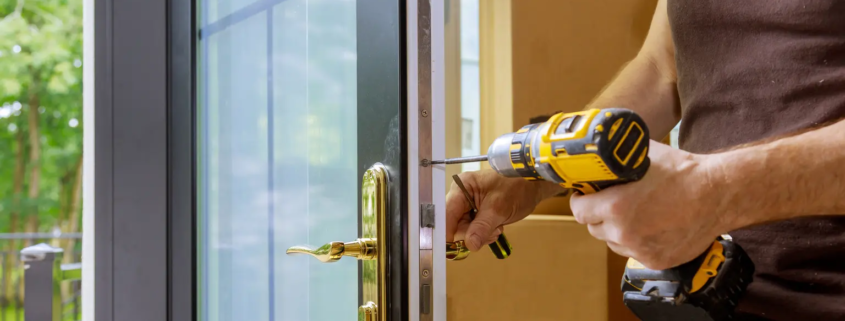The Complete Guide to Door Replacement: Costs, Materials & DIY Tips (2025)
Replacing a door might seem like a small project, but it can have a significant impact on your home’s energy efficiency, security, and curb appeal. Whether you’re looking to upgrade your front door, replace an interior door, or improve your home’s insulation, this guide covers everything you need to know.
Why Replace a Door?
1. Energy Efficiency
Old doors can be drafty, leading to higher energy bills. Upgrading to an energy-efficient door can help seal your home and reduce heating and cooling costs. According to the U.S. Department of Energy, replacing or weatherstripping exterior doors can save money and energy in your home.
2. Security
Modern doors come with enhanced security features, including better locks and sturdier materials, providing increased protection against break-ins.
3. Aesthetic Appeal
A new door can dramatically change the look of your home, boosting its curb appeal and potentially increasing its market value.
Understanding Door Replacement Costs
The cost of replacing a door varies based on several factors, including the type of door, materials used, and labor costs.
Average Costs in 2025
| Door Type | Average Cost Installed |
|---|---|
| Interior Door | $178 – $398 |
| Exterior Door | $398 – $998 |
| Front Door | $500 – $2,500+ |
Note: These are average estimates. Actual costs can vary based on location and specific project requirements.
Choosing the Right Door Material
Selecting the appropriate material is crucial for durability, maintenance, and energy efficiency.
Comparison of Door Materials
| Material | Pros | Cons |
|---|---|---|
| Wood | Classic look, customizable | Requires maintenance, can warp |
| Steel | Durable, cost-effective, secure | Can rust, limited design options |
| Fiberglass | Energy-efficient, low maintenance | Higher upfront cost |
| Aluminum | Lightweight, corrosion-resistant | Less insulating than other materials |
| uPVC | Affordable, low maintenance | Less durable, limited aesthetic appeal |
Each material has its unique advantages. Consider your specific needs and budget when choosing.
DIY: How to Replace a Door
Replacing a door can be a DIY project if you have the right tools and follow the steps carefully.
Tools Needed
-
Tape measure
-
Screwdriver
-
Hammer
-
Level
-
Shims
-
Drill
-
Utility knife
-
Caulk and caulking gun
Step-by-Step Guide
-
Measure the Existing Door
-
Measure the width, height, and thickness of the existing door.
-
Note the hinge placements and lockset positions.
-
-
Remove the Old Door
-
Unscrew the hinges and carefully remove the door from the frame.
-
-
Prepare the New Door
-
If it’s not pre-hung, you’ll need to chisel out spaces for hinges and drill holes for the lockset.
-
-
Install the New Door
-
Position the door in the frame.
-
Use shims to ensure it’s level and plumb.
-
Screw the hinges into place.
-
-
Seal and Finish
-
Apply caulk around the frame to seal any gaps.
-
Paint or stain the door as desired.
-
For a visual guide, check out this DIY Front Door Replacement.
Energy Efficiency and Tax Credits
Upgrading to an energy-efficient door not only reduces utility bills but may also qualify you for tax credits.
Benefits
-
Lower Energy Bills: Energy-efficient doors help maintain indoor temperatures, reducing the need for heating and cooling.
-
Tax Incentives: You can claim up to 30% of the product cost, with a maximum of $500 ($250 per door), as a tax credit for energy-efficient exterior doors.
Ensure the door is ENERGY STAR certified to qualify for these benefits.
Hiring a Professional vs. DIY
While DIY can save money, hiring a professional ensures the job is done correctly, especially for exterior doors that require precise installation for security and insulation.
Considerations
-
DIY: Suitable for interior doors or if you have carpentry experience.
-
Professional: Recommended for exterior doors, especially if structural changes are needed.
Average professional installation costs range from $546 to $2,375, depending on the door type and complexity.
Final Tips
-
Measure Accurately: Always double-check measurements before purchasing a new door.
-
Check Local Codes: Ensure the new door meets local building codes, especially for fire-rated or storm-resistant doors.
-
Maintenance: Regularly inspect and maintain your doors to extend their lifespan.
FAQS about Door Replacement
1. How do I know if my door needs to be replaced?
If your door is sticking, has visible cracks, feels drafty, or is hard to lock properly, it might be time for a replacement. Other signs include rust on metal doors, warping in wood doors, or rising energy bills due to poor insulation.
2. What’s the best material for a front door?
It depends on your priorities:
-
Steel: Best for security and durability.
-
Fiberglass: Great for energy efficiency and low maintenance.
-
Wood: Ideal for a traditional look, but requires regular upkeep.
3. Can I replace a door myself, or should I hire a pro?
If you’re comfortable with tools and it’s a basic interior door, DIY is possible. For front doors or custom fits, it’s best to hire a professional to ensure proper alignment, insulation, and security.
4. How long does door replacement take?
A basic door replacement typically takes 2–4 hours, but it may take longer if there are issues with the frame, trim, or weatherproofing.
5. Are there tax credits for replacing my door?
Yes! If you install an ENERGY STAR®-certified exterior door, you may qualify for a federal tax credit of up to 30% of the product cost, capped at $250 per door. Be sure to keep your receipts and certification labels for filing.



Leave a Reply
Want to join the discussion?Feel free to contribute!